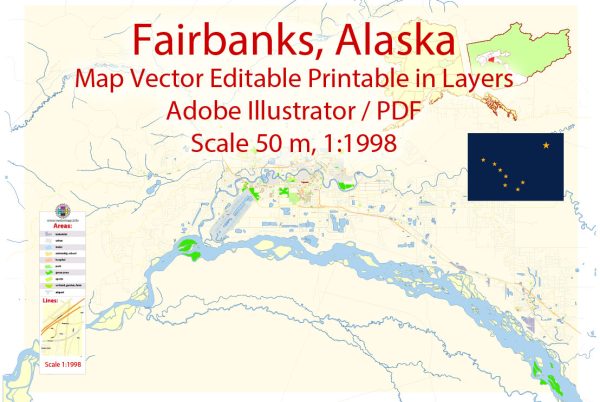Fairbanks, Alaska, has a unique history of urban development that reflects the challenges and opportunities associated with its remote location in the Interior of the state. Here is an overview of the key historical points in Fairbanks’ urban development:
- Gold Rush Era (early 20th century):
- Fairbanks owes its existence to the gold rush in Alaska during the early 20th century. Gold was discovered in the area in 1902, leading to a rush of prospectors and settlers.
- The city’s growth was rapid, and by 1903, it was officially established. The downtown area was quickly developed to accommodate the needs of the growing population.
- Role of the Tanana Valley Railroad:
- The Tanana Valley Railroad played a crucial role in Fairbanks’ development by connecting the city to the steamboat port of Chena Slough and providing transportation for people and goods.
- The railroad facilitated the movement of mining equipment and resources, contributing to the economic prosperity of the region.
- Impact of World War II:
- Fairbanks played a significant role during World War II as a transportation and supply hub for the military. The construction of the Alaska Highway and the Canol Pipeline further boosted the city’s importance.
- The wartime infrastructure improvements had a lasting impact on Fairbanks’ development, providing a foundation for future growth.
- Expansion of the University of Alaska Fairbanks (UAF):
- The establishment and expansion of the University of Alaska Fairbanks in 1917 have been influential in shaping the city. The university has played a crucial role in education, research, and cultural development in the region.
- Economic Diversification:
- Over the years, Fairbanks has seen efforts to diversify its economy beyond mining. Tourism, government services, and education have become significant contributors to the local economy.
- Challenges of Remote Location:
- Fairbanks faces challenges associated with its remote location, including harsh weather conditions, limited road access, and a short growing season. These factors have influenced urban planning and infrastructure development.
- Cultural and Community Development:
- The city has a rich cultural heritage, with influences from Alaska Native communities and a diverse population. The Fairbanks community has actively worked to preserve its history and traditions while embracing modern developments.
- Modern Urban Planning:
- In recent decades, Fairbanks has engaged in urban planning efforts to address issues such as transportation, infrastructure, and land use. The city has aimed to balance growth with environmental sustainability and quality of life for residents.
Overall, Fairbanks, Alaska, has evolved from a frontier mining town to a diverse and vibrant urban center, overcoming the challenges posed by its remote location. The city’s history is deeply intertwined with the natural resources of the region, its strategic importance during wartime, and ongoing efforts to build a resilient and sustainable community.


 Author: Kirill Shrayber, Ph.D.
Author: Kirill Shrayber, Ph.D.